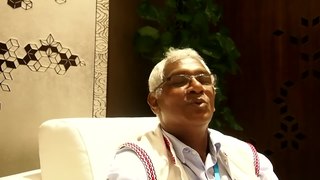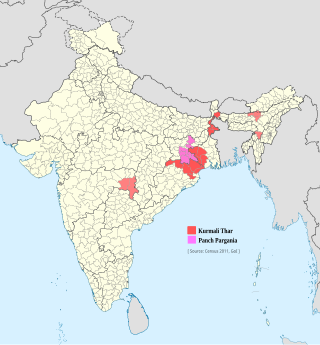Related Research Articles
Bihari languages is a group of the Indo-Aryan languages. The Bihari languages are mainly spoken in the Indian states of Bihar, Jharkhand, Uttar Pradesh, and West Bengal, and also in Nepal. The most widely spoken languages of the Bihari group are Bhojpuri, Magahi and Maithili.

The Munda languages are a group of closely related languages spoken by about nine million people in India and Bangladesh. Historically, they have been called the Kolarian languages. They constitute a branch of the Austroasiatic language family, which means they are more distantly related to languages such as the Mon and Khmer languages, to Vietnamese, as well as to minority languages in Thailand and Laos and the minority Mangic languages of South China. Bhumij, Ho, Mundari, and Santali are notable Munda languages.

The Kharia language is a Munda language of the Austroasiatic language family, that is primarily spoken by the Kharia people of eastern India.
Vedic Sanskrit has a number of linguistic features which are alien to most other Indo-European languages. Prominent examples include: phonologically, the introduction of retroflexes, which alternate with dentals, and morphologically, the formation of gerunds. Some philologists attribute such features, as well as the presence of non-Indo-European vocabulary, to a local substratum of languages encountered by Indo-Aryan peoples in Central Asia (Bactria-Marghiana) and within the Indian subcontinent during Indo-Aryan migrations, including the Dravidian languages.

Nagpuri is an Indo-Aryan language spoken in the Indian states of Jharkhand, Chhattisgarh, Odisha and Bihar. It is primarily spoken in the west and central Chota Nagpur plateau region. It is considered a dialect of Bhojpuri.
Mundari (Munɖari) is a Munda language of the Austroasiatic language family spoken by the Munda tribes in eastern Indian states of Jharkhand, Odisha and West Bengal. It is closely related to Santali. Mundari Bani, a script specifically to write Mundari, was invented by Rohidas Singh Nag. It has also been written in the Devanagari, Odia, Bengali, and Latin writing systems.
Sadan may refer to:
Asuri is an Austroasiatic language spoken by the Asur people, part of the Munda branch. Asuri has many Dravidian loanwords due to contact with Kurukh.
Chik Baraik is a community found in Indian State of Jharkhand, Chhattisgarh, Odisha. They were traditionally Weaver.

The Eastern Indo-Aryan languages, also known as Māgadhan languages, are spoken throughout the eastern region of the subcontinent, which includes Bihar, Uttar Pradesh, Jharkhand, Bengal region, Tripura, Assam, and Odisha; alongside other regions surrounding the northeastern Himalayan corridor. Bengali is official language of Bangladesh and the state of West Bengal, Tripura and the Barak valley of Assam while Assamese and Odia are the official languages of Assam and Odisha, respectively. The Eastern Indo-Aryan languages descend from Abahattha, which descends from Magadhan Apabhraṃśa and ultimately from Magadhi Prakrit.

Kurmali or Kudmali is an Indo-Aryan language classified as belonging to the Bihari group of languages spoken in eastern India. As a trade dialect, it is also known as Panchpargania, for the "five parganas" of the region it covers in Jharkhand. Kurmali language is spoken by around 5.5 lakh people mainly in fringe regions of Jharkhand, Odisha and West Bengal, also a sizeable population speak Kurmali in Assam tea valleys. Intellectuals claim that Kurmali may be the nearest form of language used in Charyapada. Kurmali is one of the demanded languages for enlisting in Eighth Schedule to the Constitution of India.
Most of the languages of Bihar, the third most populous state of India, belong to the Bihari subgroup of the Indo-Aryan family. Chief among them are Bhojpuri, spoken in the west of the state, Maithili in the north, Magahi in center around capital Patna. Maithili has official recognition under the Eighth Schedule to the Constitution of India. The official language of Bihar is Modern Standard Hindi, with Standard Urdu serving as a second official language in 15 districts.

Jhumair or Jhumar is an Indian folk dance from the Indian states of Jharkhand, Odisha, Chhattisgarh, Assam, Bihar and West Bengal. It is folk dance of Sadan, the Indo-Aryan ethnic groups of Chotanagpur. It is mainly performed during harvest season. The musical instruments used are Mandar, Dhol, Nagara, Bansuri. This dance style consists of performers standing in a row holding hands, singings couplets, swaying their bodies, clapping their hands and occasionally adding timed jumps.

Khortha or alternatively classified as Eastern Magahi is a language spoken primarily in the Indian state of Jharkhand, mainly in 16 districts of three divisions: North Chotanagpur, Palamu division and Santhal Pargana. Khortha is spoken by the Sadaans as native language and used by the tribal as a link language. It is most spoken language of Jharkhand.
The Kudmi Mahato are a tribal community in the states of Jharkhand, West Bengal and Odisha of India. They are primarily agriculturalist.
The state of Jharkhand in India is located in the eastern part of the country and is known for its vivid culture, distinct paintings, traditions and festivals.
The Nagpuria people, also Nagpuri or Sadan, are an Indo-Aryan speaking ethnolinguistic group who are the native speakers of the Nagpuri language and natives of the western Chota Nagpur Plateau region of Indian states of Jharkhand, Bihar, Chhattisgarh and Odisha.
Sadan are the native Indo-Aryan-speaking ethnolinguistic groups of Chota Nagpur Plateau consist of Indian state of Jharkhand and neighbouring states who speak Nagpuri, Khortha and Kurmali language as their native language.
The Inner–Outer hypothesis of the subclassification of the Indo-Aryan language family argues for a division of the family into two groups, an Inner core and an Outer periphery, evidenced by shared traits of the languages falling into one of the two groups. Proponents of the theory generally believe the distinction to be the result of gradual migrations of Indo-Aryan speakers into the Indian subcontinent, with the inner languages representing a second wave of migration speaking a different dialect of Old Indo-Aryan, overtaking the first-wave speakers in the center and relegating them to the outer region.
Girdhari Ram Gonjhu was a prominent scholar of the Nagpuri language. He was former chairman of the Tribal-Regional Language Department at Ranchi University in state of Jharkhand. He was awarded Padma Shri for his contribution in the field of literature and education in the Jharkhand posthumously in 2022.
References
- 1 2 3 4 Paudyal, Netra P.; Peterson, John (2020-09-01). "How one language became four: the impact of different contact-scenarios between "Sadani" and the tribal languages of Jharkhand". Journal of South Asian Languages and Linguistics. 7 (2): 275–306. doi: 10.1515/jsall-2021-2028 . ISSN 2196-078X.
- ↑ Savita Kiran, John Peterson. "Sadani / Sadri". academia.edu. Retrieved 5 October 2022.
- ↑ Hans Henrich Hock, Elena Bashir (2016). The Languages and Linguistics of South Asia: A Comprehensive Guide. Walter de Gruyter GmbH & Co KG. p. 316. ISBN 978-3110423303.